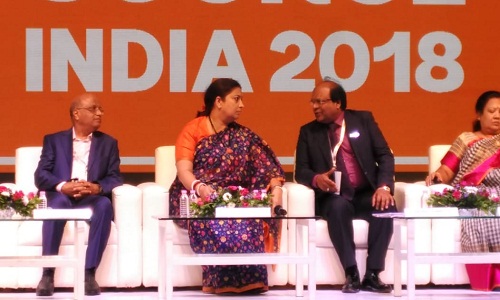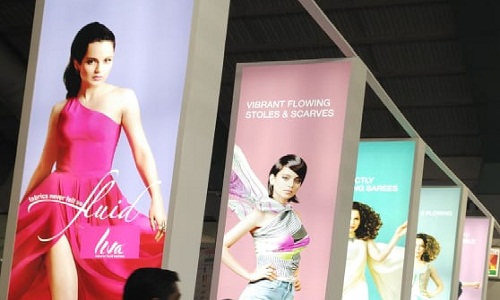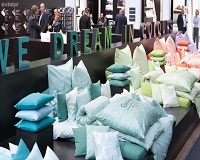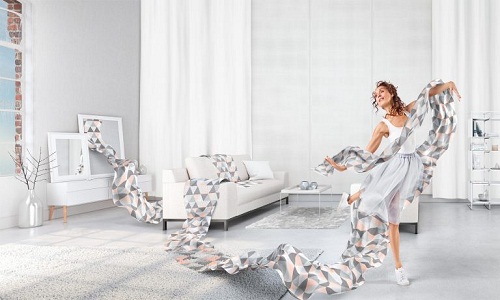FW
India’s cotton exports to China may see a fivefold jump after China slapped additional duty on imports of the fiber from the US amid a trade standoff between the two economies. Indian traders have already entered into a forward contract with Chinese buyers to deliver about 1.2 million bales between November and January.
However, a likely decline in India’s cotton production in the next season, low closing stocks and higher minimum support prices might dent India’s export prospects. Thanks to the new minimum support price, cotton prices will rise by a whopping 28 per cent. Given the conversion ratio of around 33 per cent the prices of finished cotton will be up 20 per cent from current global prices. At this price, India’s cotton exports will be uncompetitive, though the rupee’s fall would cushion the fall a bit.
China’s cotton stocks have reduced and it has become a net importer to meet its garment demand. It has an annual output of 35 million bales against consumption of about 50 million bales. The country has not been able to increase cotton production in recent years since the focus shifted to food and feed crops. China’s buffer cotton stocks began depleting since 2015. India’s cotton output for the 2017-18 season is estimated as seven per cent higher from the previous year. Next season’s output is expected to be slightly less than this year’s.
A large number of garment workers located in H&M’s supply chain get a living wage. A huge proportion of the company's product volume is now produced in factories that have improved on wage standards and human rights. H&M launched its fair living wage strategy in 2013, aiming at ensuring that all supply chain workers receive a wage that is enough to support a family and is earned during legal working hour limits.
Since 2013, the number of factories supplying to H&M covered by the strategy has increased from three to 655. More than 9,30,000 workers are located in these factories, which account for 84 per cent of product volume. As a buyer, H&M focuses the management process of wage standards, rather than imposing specific wage levels for suppliers. The fashion retailer is working with factories to embed fair negotiating processes between governments, employers, worker representatives and the wider labor market.
More than two-thirds of H&M’s product volume is sourced from factories that are implementing improved wage management systems – covering 6,35,000 workers. The company has a time-specific target to ensure that worker representatives cover 100 per cent of factories that H&M works with across Bangladesh. Globally, 73 per cent of H&M’s product volume is located in factories that have democratically elected worker representation.
FESPA Africa 2018, held from September 12-14, 2018 attracted 6,494 visitors, with 5,907 unique visits – an increase from 2017 representing the growth and opportunities in the region. The visitors spanned top 10 countries from outside South Africa including Zimbabwe, Botswana, Mozambique, Zambia, Swaziland, Lesotho etc. Representation from other countries also included: Namibia, Nigeria, Tanzania etc.
Along with the latest machinery, products and software solutions, visitors were able to particpate in a range of educational features such as the textile experience, a hands-on workshop where printers could learn different techniques by Charlie Taublieb, T-shirt and bag printing workshops, CorelDRAW workshops, the Speed Wrap Challenge and Business Opportunities in print and signage, which were held on various exhibitors’ stands.
China, Japan and South Korea are working toward a free trade agreement. Speeding up FTA negotiations is expected to benefit the three countries together in the face of threats from unilateralism and protectionism. While China may seek an agreement more urgently, Japan and South Korea are more cautious. Negotiations are progressing slowly due to the countries’ competitive industrial structures.
To further accelerate an FTA, the three countries may exercise greater flexibility and creativity than before on the major issues, such as goods, services and investment. On trade, in particular, they may develop a mentality to bring about fair contributions and a balance of interests, reflecting differences among the three countries in their trade structures.
The three countries have relatively strong economic ties and together account for 20 per cent of global GDP. But South Korea and Japan are allied to the US, which sees China as a strategic rival. China has stepped up efforts to build a global trade network with greater use of FTAs to diversify its markets and counter protectionism. So far China has 17 FTAs with 25 countries and regions, and is in talks over 12 new or upgraded FTA deals.
Such efforts have become more evident in the past two years, especially after the US began imposing punitive tariffs on Chinese goods to push the world’s second largest economy to lower its market barriers.
"The 2nd edition of ‘Source India’, a three-day mega event organized by Silk & Rayon Textile Export Promotion Council (SRTEPC) is on in Surat from September 21-23, 2018 at the Surat International Exhibition & Convention Centre. The mega textile show, backed by the Union Ministry of Commerce, is being organised under the MAI Scheme of the Central government. “It is an opportunity to amalgamate the force and talent of the young,” says Smriti Irani, Minister of Textiles. “The theme pavilion has been designed by The National Institute of Fashion Technology and displays future trends and colors,” she says."
 The 2nd edition of ‘Source India’, a three-day mega event organized by Silk & Rayon Textile Export Promotion Council (SRTEPC) is on in Surat from September 21-23, 2018 at the Surat International Exhibition & Convention Centre.
The 2nd edition of ‘Source India’, a three-day mega event organized by Silk & Rayon Textile Export Promotion Council (SRTEPC) is on in Surat from September 21-23, 2018 at the Surat International Exhibition & Convention Centre.
The mega textile show, backed by the Union Ministry of Commerce, is being organised under the MAI Scheme of the Central government. “It is an opportunity to amalgamate the force and talent of the young,” says Smriti Irani, Minister of Textiles. “The theme pavilion has been designed by The National Institute of Fashion Technology and displays future trends and colors,” she says.
A great opportunity for buyers, exhibitors
Source India 2018, the flagship export promotion program of the Council, offers an excellent platform to SRTEPC member-companies to meet and discuss business with around 200 potential foreign buyers under one roof by developing long term and mutually beneficial relationships with them. Around 200 leading buyers from 40 countries have been invited to source their requirement of Indian man-made fibre textile products from member exporters.
SRTEPC member-companies to meet and discuss business with around 200 potential foreign buyers under one roof by developing long term and mutually beneficial relationships with them. Around 200 leading buyers from 40 countries have been invited to source their requirement of Indian man-made fibre textile products from member exporters.
Exhibitors include 150 manufacturers/exporters of man-made textiles from 35 countries. They will showcase their latest range of synthetic and rayon textile fabrics used for making men’s and ladies outfits, made-ups and other products.
Good platform for networking
 SRTEPC has also invited leading international buying houses, retail chains and agents based in India to visit the event for discussing business with prospective textile suppliers. “The council adopted a scientific approach to reach out to around 12 countries by personally visiting and speaking to industry bodies. They studied the import capacities of various nations, trends that Surat can service in those countries, and then extended invitations to those trades,” Irani explains.
SRTEPC has also invited leading international buying houses, retail chains and agents based in India to visit the event for discussing business with prospective textile suppliers. “The council adopted a scientific approach to reach out to around 12 countries by personally visiting and speaking to industry bodies. They studied the import capacities of various nations, trends that Surat can service in those countries, and then extended invitations to those trades,” Irani explains.
The three-day mega textile show is a ‘not- to-be-missed opportunity’ for apparel manufacturers to meet future suppliers.
"The world’s leading trade fair for home and contract textiles, Heimtextil, to take place from January 8-11, 2019 in Frankfurt, is now expanding its spectrum across a six hall levels. With over 400 international manufacturers, the product range of upholstery and decorative fabrics as well as upholstery and artificial leather at Heimtextil is wider than ever before. Olaf Schmidt, VP – textiles & textile technologies, Messe Frankfurt, stated, “The upholstery and decorative fabrics segment has been growing very successfully for several years now. In 2019, all the relevant European suppliers of upholstery and decorative fabrics, upholstery and artificial leather will be presenting themselves across the three levels of hall 4 for the first time. The most important manufacturers of upholstery fabrics from Asia that also have export experience will also be represented in halls 1 and 5.”
 The world’s leading trade fair for home and contract textiles, Heimtextil, to take place from January 8-11, 2019 in Frankfurt, is now expanding its spectrum across a six hall levels. With over 400 international manufacturers, the product range of upholstery and decorative fabrics as well as upholstery and artificial leather at Heimtextil is wider than ever before. Olaf Schmidt, VP – textiles & textile technologies, Messe Frankfurt, stated, “The upholstery and decorative fabrics segment has been growing very successfully for several years now. In 2019, all the relevant European suppliers of upholstery and decorative fabrics, upholstery and artificial leather will be presenting themselves across the three levels of hall 4 for the first time. The most important manufacturers of upholstery fabrics from Asia that also have export experience will also be represented in halls 1 and 5.”
The world’s leading trade fair for home and contract textiles, Heimtextil, to take place from January 8-11, 2019 in Frankfurt, is now expanding its spectrum across a six hall levels. With over 400 international manufacturers, the product range of upholstery and decorative fabrics as well as upholstery and artificial leather at Heimtextil is wider than ever before. Olaf Schmidt, VP – textiles & textile technologies, Messe Frankfurt, stated, “The upholstery and decorative fabrics segment has been growing very successfully for several years now. In 2019, all the relevant European suppliers of upholstery and decorative fabrics, upholstery and artificial leather will be presenting themselves across the three levels of hall 4 for the first time. The most important manufacturers of upholstery fabrics from Asia that also have export experience will also be represented in halls 1 and 5.”
Underlining themes
Healthy living and working remains one of the top themes in the interior textiles sector. Furniture and decorative fabrics also make a contribution: they are able to optimise rooms climatically and acoustically and decisively improve the feel-good factor. In this respect, the on-trend fabrics are certified organic, waterproof and/or flame-retardant. At the same time, the textiles, despite all their high-tech, have a very natural appearance. This also applies to outdoor fabrics in linen, flannel or woven looks. When it comes to soft feel-good textiles for indoors, high quality wool is exploited to the full. Additionally, denim fabrics that sometimes give the interior a casual touch are also on the rise. On the first day, a design dialogue will take place with the Heimtextil trend managers about the latest design trends in upholstery and decorative fabrics. The trend researchers will invite representatives from the upholstery industry to the lecture area in hall 4.2 to exchange views on current topics.
fabrics also make a contribution: they are able to optimise rooms climatically and acoustically and decisively improve the feel-good factor. In this respect, the on-trend fabrics are certified organic, waterproof and/or flame-retardant. At the same time, the textiles, despite all their high-tech, have a very natural appearance. This also applies to outdoor fabrics in linen, flannel or woven looks. When it comes to soft feel-good textiles for indoors, high quality wool is exploited to the full. Additionally, denim fabrics that sometimes give the interior a casual touch are also on the rise. On the first day, a design dialogue will take place with the Heimtextil trend managers about the latest design trends in upholstery and decorative fabrics. The trend researchers will invite representatives from the upholstery industry to the lecture area in hall 4.2 to exchange views on current topics.
Europe’s strong presence
Hall 4 will host numerous big names from Europe including Gruppo Mastrotto, Manifattura Tessile Di Nole, Martinelli Ginetto, MCA, Prosetex and Sirio Tendaggi from Italy, Boelert & Moens, De Poortere Frères, Symphony Mills and Tessutica (with the Beaulieu brand) from Belgium and Albatros, Bernard Reyn, Pintail and Reynaldo from the Netherlands. Other top players come from Spain include Manuel Revert, Santa Amalia Alta Decoracion (with the brand SATI) and Textiles Vilber. In addition, Dina Vanelli Tekstil and Güleser Tekstil from Turkey will also be present. From Germany, Gebrüder Munzert, Konrad Hornschuch, Leder Schreyeck, Textum and Vowalon Beschichtungen will be represented.
Commercial textile furnishing
Hall 4.2 will also focus on a further target group: interior, architecture, hospitality expo, architects, interior designers and hotel furnishers will find high-quality products for commercial textile furnishing, such as textiles with an acoustic function or with special abrasion-resistant properties. Crypton from the US and Anavil Europe from France will be exhibiting for the first time presenting fabrics specifically for contract furnishing. Another highlight of hall 4.2 will be a large-scale presentation by Trevira. “We will further expand the concept of the Trevira CS joint stand in 2019. This means that we will be represented at Heimtextil with a larger number of customers and thus also the highly flame-retardant Trevira CS collections. Trevira will also be presenting a trend area especially for the contract market, where visitors, in particular interior designers, designers and furnishers, can find out about innovative textiles and colour trends,” said Dr Isabell Lammel, manager communications, Trevira.
German manufacturer of high-tech polyester fibres and filaments will be presenting new products alongside its well-known partners, such as Getzner Textil from Austria, Engelbert E. Stieger from Switzerland, Hoftex from Germany, Johan van den Acker from the Netherlands and Tessitura Mario Ghioldi from Italy.
Asian highlights
Halls 1.0, 1.1 and 5.1, Asian manufacturers experienced in exports will present a wide range of furnishing and upholstery fabrics on a total of three levels. This is where foreign traders and wholesalers focusing on volume-oriented orders can meet manufacturers with whom orders can be placed in medium and high quantities and supplied in a timely manner.
In addition to the joint presentation by Trevira in hall 4.2, numerous manufacturers of fibres and yarns will be exhibiting at Heimtextil, spread across various product segments. The range extends from traditional materials and eco-certified yarns to high-tech fibres for use in highly specialised areas.
The Israeli Ministry of Economy, has launched a national plan to strengthen clothing and fashion industry with 22 million new shekels ($6.14 million) investment. The plan will not extend the temporary exemption from customs duties on clothing by the end of 2018. For major products, customs duties will return to standard rate of 12 per cent. Around 10 million new shekels will be invested in upgrading and promoting plans with the Israeli Innovation Authority. The money will be used to grant 30 to 50 per cent of the R&D expenditures of programs approved for fashion manufacturers.
An additional 9 million new shekels will be allocated to promote export activity through an internet portal and free guidance by the Israel Export Institute. Another 3 million new shekels will be allocated to promote online trading in small and medium businesses. In addition, manufacturers will be able to receive export support of up to 200,000 new shekels each.
Primark plans to expand the Primark Sustainable Cotton Programme to encompass suppliers in Pakistan. The retailer plans to enroll 30,000 farmers on the programme by 2022, receiving training and support in order to successfully provide Primark with cotton that adheres to its sustainability criteria.
The Primark Sustainable Cotton Programme was established to train and support smallholder farmers in the application of ‘sustainable’ farming methods. In association with CottonConnect, growers are educated on the most appropriate farming techniques for their land. This advice covers topics including seed selection, sowing, soil, water, pesticides and pest management, picking, fibre quality, grading and storage of harvested crop.
The initial roll-out of the programme began in 2013 and was exclusive to India, with over 6,000 independent farmers in Gujarat working with the programme pioneered by the high street retailer. On average, Primark claims, profits increased by almost 200 per cent for those who completed training; a figure which almost certainly makes the initiative easy to sell to many independent Pakistani growers. In the next phase of development, Primark worked alongside CottonConnect and REEDS to introduce the programme into Pakistan.
Gap might increase prices due to tariffs on Chinese goods. While most of its products are from Vietnam, about 22 per cent still come from China. As the retailer plans to continue moving away from China and expand sourcing to other nations, but there are certain items — like sweaters — where China has a strong advantage. And this will ultimately be a tax on the consumer.
The trade dispute is just one of the challenges facing Gap. The company has struggled with declining mall traffic, operational missteps and disappointing growth. The Gap brand, in particular, has fallen short, and the company is increasingly relying on its Athleta and Old Navy chains for growth. The company’s success with its Athleta brand inspired its new men’s brand, Hill City, which fuses sportswear with everyday apparel.
Over the next five years, Gap plans to ramp up its acquisitions, using Athleta as a model. Gap will eye other companies with a similar profile that don’t have a lot of stores and could benefit from Gap’s platform. The company will also seek to boost e-commerce, hoping online sales make up as much as 60 per cent of sales by 2023. The company may have the same amount of stores by then, but they’ll be smaller and with more technology enhancements.
Sportswear maker Under Armour will slash around 400 jobs, or 3 per cent of its global workforce, in order to cut costs in its struggle to compete with Nike and Germany’s Adidas in North America. This is the second round of job cuts for the Baltimore-based company, which cut 277 jobs last year as part of a 2017 restructuring plan. The company had about 15,800 employees at the end of last year, and the workforce cuts are expected to be completed by March 2019. Under Armour expects to incur between $200 to $220 million in expenses for the latest rejig, which would be the final update to its 2018 restructuring program, slightly higher than an earlier estimate. Under Armour now expects annual adjusted earnings of 16 to 19 cents per share, compared with a previous estimate of 14 to 19 cents. Under Armour's sales in North America have risen only once in the past four quarters as it faced up to new sales pushes by its bigger rivals, and it expanded its cost-cutting programme in February.











